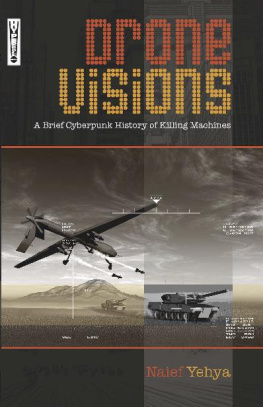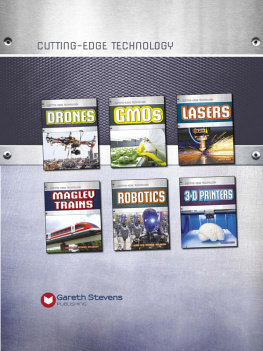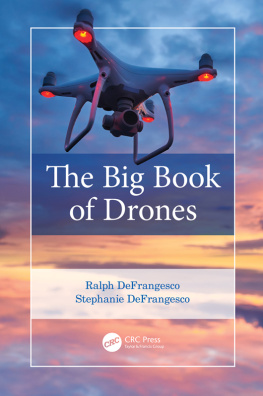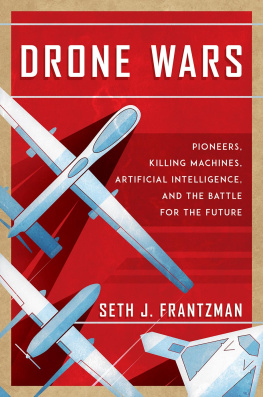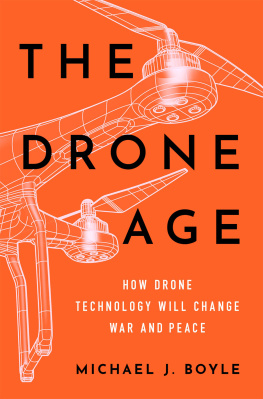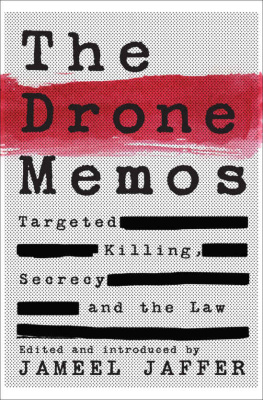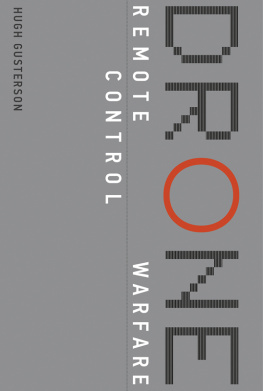Drone
Visions
Drone
Visions
A Brief Cyberpunk History of Killing Machines
Naief Yehya
English Translation by Uriel Murillo Sosa,
Lorenzo Antonio Nericcio, and Naief Yehya
Hyperbole Books, an SDSU Press Imprint
Drone Visions: A Brief Cyberpunk History of Killing Machines by Naief Yehya is published by Hyperbole Books, an imprint of San Diego State University Press.
No part of this book may be used or reproduced in any manner whatsoever without prior permission from San Diego State University Press. These permissions are waived in the case of brief quotations use d
in critical articles and reviews.
San Diego State University Press and
Hyperbole Books publications may be
purchased at discount for educational,
business, o r
sales promotional use. For
information writ e
SDSU Press, 5500
Campanile Drive, SDSU ,
San Diego,
California 92182-6020.
Copyright 2020 Naief Yehya
ISBN-13: 978-1-938537-78-3
ISBN-10: 1-938537-78-5
hype.sdsu.edu
sdsupress.sdsu.edu
facebook.com/sandiegostateuniversitypress
Cover design by Antonio Sacristan Fanjul
Book Design by Guillermo Nericcio Garca
FIRST EDITIO N
PRINTED IN THE UNITED STATES OF AMERICA
Across the communications landscape
move the specters of sinister technologies.
J.G. Ballard
From the foreword to the
French edition of Crash (1974)
Television War
During the first Gulf War (1990-1991), CNN managed to create a new type of televised spectacle by turning war into episodic entertainment. One of the main attractions was showing the point of view of allegedly intelligent missiles equipped with cameras on their noses, that rained down with surgical precision, shattering and eliminating military and strategic targets in Bagdad and other Iraqi cities. During that war, the focus was on smart bombs, high power explosives that used laser or satellite guidance; these next-generation flying machines were assumed to be infallible, producing minimum collateral damage. The missile-camera impact that filmed its own destruction was the equivalent of porns money shot (the proverbial and indispensable external ejaculation shot), as it summarized a narrative through a precise and climactic explosion and made any conflict rhetoric irrelevant. Thanks to the CNN Effect, war was transformed into an illusion of technological confrontation, where human victims were not shown, while military paraphernalia bombs, aircraft carriers, and military jets were the stars of the show, obsessively displayed and celebrated. These ecstatic nationalistic scenes disguised wars crudeness by reducing it to visual spectacleimages and graphics that recall action cinema, video games and televised sports. The media success, of this highly edited and censored televised propaganda campaign, was decisive in the establishment of a new political-military ideology that proclaimed the notion of humanely transforming the world through the use of aggressive cutting-edge military technology, long-distance missiles, and new forms of cheap interventionism.
Ideologists at the Pentagon and the White House, principally of the neoconservative persuasion but also of other strains, had the dangerous fantasy that this technology would allow them, at low cost and without the necessity of either sending new troops (boots on the ground) or maintaining existing invasions, to decapitate enemy leadership, eradicate guerrillas, kill popular insurgent heroes and problematic leaders, change inconvenient governments, and squash militias that antagonized expansionism and imperial interests. Despite the fact that at the beginning of the war on terror precision bombardments destroyed a large part of military and defense infrastructure in Afghanistan and Iraq, the allies subsequently continued with indiscriminate saturation bombing, with which they obliterated neighborhoods, power and water treatment plants, schools, factories, temples, and more. Hence, the supposed initial efforts to protect innocent lives were, in large part, absurd and purely propagandistic. In a short time, it became clear that smart missiles where not as brilliant as the army spokespeople and media pitchmen had promised. The precision obtained by their guidance systems was questionable, in addition to also being very costly. In the end, ground intelligence, relations with locals, and humanitarian help were more effective than mile-high warfare. Numerous decapitating attacks launched at enemies to force their surrender without need for combat failed miserably, causing enormous collateral damage, and the disastrous destabilization of the region.
Then came the drone, a robot aircraft that presented itself as an intelligent and humanitarian weapon, an instant solution for international conflicts that would presumably open the door towards a new era of imperial wars and Pax Americana . Interventions would be conducted with minimal to no risk in any vulnerable country. The world powers will have unlimited and unrestricted access to the natural resources of poor and hostile, or third world countries. No national resistance would have any chance of defense against these remote-controlled war machines. However, these dreams of power have now generally proved false, given that, far from creating a docile and manipulable world, they have provoked chaos, new war fronts, unexpected schisms, resentments, and undesirable fractures in old alliances. Naturally, there are large corporations benefitting and acquiring wealth from these wars. The technopolitical and necrophile war fantasy becomes more and more popular, interweaving with popular science fiction narratives, and creating the conditions for the next global catastrophes. In the following pages we will try to trace the origins of the cyber war mythology, a cult with foundations in cinema, videogames and nerd obsessions with technology.
The Cyberpunk Film Canon
Four science fiction films made between the late 70s and early 80s prove essential in attempting to decipher the strange influences of popular culture at the end of the century. These films, seemingly simple commercial entertainment, pigeonholed into minor genres, were packed with action and special effects, and soon revealed their avant-garde nature, going on to configure a canon of ominous New World Order visions while spawning an ethical and aesthetic renaissance. These films demonstrated the renewed chameleonic and subversive power of a cinematographic industry that, despite Hollywoods limitations (though one did originate in Australia), restrictions, ideological and commercial impositions, they offered acute political observations of and moral insights into the culture of its time. It is no coincidence the four works questioned the ideals of progress in a world in ideological chaos that came about during the final phase of the Cold War, at a time when abuse of fossil fuels and immoderate exploitation of resources were proven to be the cause of the irreversible toll that we recognize today as global climate change. In a way the films represent the testament of the late Anthropocene.
The films are George Millers Mad Max (1979), Ridley Scotts Alien (1979) and Blade Runner (1982), and James Camerons Terminator (1984). All of these had sequels that consolidated the end-of-the-century techno pessimism and became academic, cult, and cultural criticism obsessions. These films influenced hundreds of imitations and paraphrases throughout the world, resonated within literature, visual arts, music, and comics, shook off the vestiges of the post-hippie unconscious, made technology cool, and eventually engendered cyberpunk: the rebel branch of cyberculture that attempted a capture ofor, at the very least, to hack intomedia communication resources, and to abolish the pyramidal structure imposed by authoritiesowners of the presses, television station proprietary consortia, telecommunication transnationals, and thought control agencies. Even though the term cyberpunk may seem dated in some circles, it reflects an end of the century morbid fascination with technological decay, aesthetics, and its unfulfilled promises of progress.



